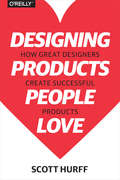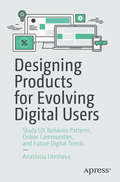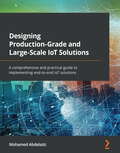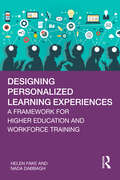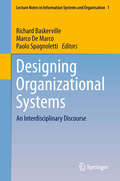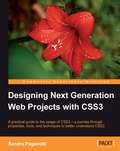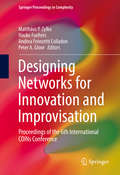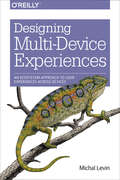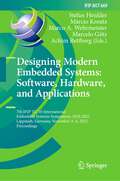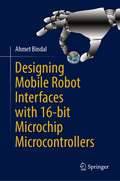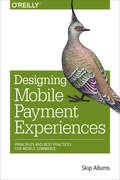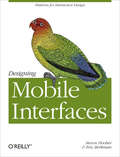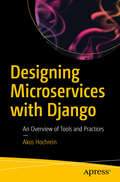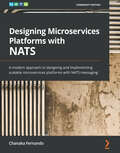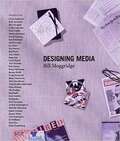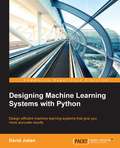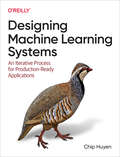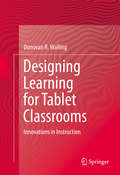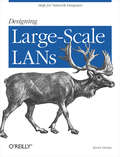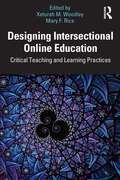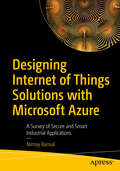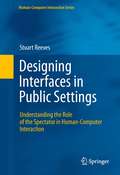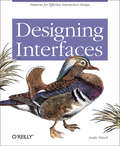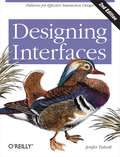- Table View
- List View
Designing Products People Love
by Scott HurffHow can you create products that successfully find customers? With this practical book, you'll learn from some of the best product designers in the field, from companies like Facebook and LinkedIn to up-and-coming contenders. You'll understand how to discover and interpret customer pain, and learn how to use this research to guide your team through each step of product creation.Written for designers, product managers, and others who want to communicate better with designers, this book is essential reading for anyone who contributes to the product creation process.Understand exactly who your customers are, what they want, and how to build products that make them happyLearn frameworks and principles that successful product designers useIncorporate five states into every screen of your interface to improve conversions and reduce perceived loading timesDiscover meeting techniques that Apple, Amazon, and LinkedIn use to help teams solve the right problems and make decisions fasterDesign effective interfaces across different form factors by understanding how people hold devices and complete tasksLearn how successful designers create working prototypes that capture essential customer feedbackCreate habit-forming and emotionally engaging experiences, using the latest psychological research
Designing Products for Evolving Digital Users: Study UX Behavior Patterns, Online Communities, and Future Digital Trends
by Anastasia UteshevaDigital user behavior is evolving at an ever-increasing pace, and predicting future trends is a booming business as a result. Users associate technology with their identities now more than ever, and it is up to you as a product designer to enhance their experience for the better. Designing Products for Evolving Digital Users is a 21st century handbook that helps you do just that. By providing insights that allow you to study UX (user experience) behavior patterns, online communities, and future digital trends, Designing Products for Evolving Digital Users instills confidence and fact-based foundations for your digital creations. Author Anastasia Utesheva expertly teaches you how to account for the way the technology impacts the identity of users and how that identity shifts through ongoing interaction with a product or service. She also brings in important case studies on social media, gaming, eRetail, and more to illustrate past examples of technology’s profound impact on communal and individual identity. Digital product design’s ultimate end goal is end user satisfaction. While a myriad of material is available out there consisting of simple tips and tricks for optimal digital design, Designing Products for Evolving Digital Users is a rare and remarkable title that cohesively accounts for all environmental factors involved. Comprehend how distributed technology impacts creation and negotiation of identity and explore communities that form around digital products. UX designers, futurists, students, and industry veterans alike have an abundance of invaluable learning ahead of them in Designing Products for Evolving Digital Users. What You Will LearnLearn how to design digital products/services that resonate with and transform identity of usersStudy how digital impacts formation of identityConsider how digital technology has impacted our world and implications for future digital trendsWho This Book Is For UX designers, digital product creators, entrepreneurs, educators, philosophy of technology enthusiasts, futurists
Designing Production-Grade and Large-Scale IoT Solutions: A comprehensive and practical guide to implementing end-to-end IoT solutions
by Mohamed AbdelazizGet to grips with key IoT aspects along with modern trends, architectures, and technologies that support IoT solutions, such as cloud computing, modern app architecture paradigms, and data analyticsKey FeaturesUnderstand the big picture of designing production-grade IoT solutions from an industry expertGet up and running with the development and designing aspects of the Internet of ThingsSolve business problems specific to your domain using different IoT platforms and technologiesBook DescriptionWith the rising demand for and recent enhancements in IoT, a developer with sound knowledge of IoT is the need of the hour. This book will help you design, build, and operate large-scale E2E IoT solutions to transform your business and products, increase revenue, and reduce operational costs.Starting with an overview of how IoT technologies can help you solve your business problems, this book will be a useful guide to helping you implement end-to-end IoT solution architecture. You'll learn to select IoT devices; real-time operating systems; IoT Edge covering Edge location, software, and hardware; and the best IoT connectivity for your IoT solution. As you progress, you'll work with IoT device management, IoT data analytics, IoT platforms, and put these components to work as part of your IoT solution. You'll also be able to build IoT backend cloud from scratch by leveraging the modern app architecture paradigms and cloud-native technologies such as containers and microservices. Finally, you'll discover best practices for different operational excellence pillars, including high availability, resiliency, reliability, security, cost optimization, and high performance, which should be applied for large-scale production-grade IoT solutions.By the end of this IoT book, you'll be confident in designing, building, and operating IoT solutions.What you will learnUnderstand the detailed anatomy of IoT solutions and explore their building blocksExplore IoT connectivity options and protocols used in designing IoT solutionsUnderstand the value of IoT platforms in building IoT solutionsExplore real-time operating systems used in microcontrollersAutomate device administration tasks with IoT device managementMaster different architecture paradigms and decisions in IoT solutionsBuild and gain insights from IoT analytics solutionsGet an overview of IoT solution operational excellence pillarsWho this book is forThis book is for E2E solution architects, systems and technical architects, and IoT developers looking to design, build, and operate E2E IoT applications and solutions. Basic knowledge of cloud computing, software engineering, and distributed system design will help you get the most out of this book.
Designing Personalized Learning Experiences: A Framework for Higher Education and Workforce Training
by Helen Fake Nada DabbaghDesigning Personalized Learning Experiences offers theoretically grounded and pragmatic approaches to designing personalized learning initiatives for higher education and organizational contexts. With current research concluding that a multitude of variables can enable learners to direct their own experiences and achieve their goals, new guidance is needed to hone the range of instructional approaches, activities, and interactions available to support adult learners. This book offers practical strategies on how to design and implement effective personalized learning interventions, advance learning and engagement, encourage ownership over the learning process, and decrease attrition. Professionals in instructional design, learning and development, organizational development, consultancies, and beyond will be emboldened by the work to leverage a mix of technology-enabled social and content interactions.
Designing Organizational Systems
by Paolo Spagnoletti Marco De Marco Richard BaskervilleThis book is dedicated to the memory of Professor Alessandro (Sandro) D'Atri, who passed away in April 2011. Professor D'Atri started his career as a brilliant scholar interested in theoretical computer science, databases and, more generally information processing systems. He journeyed far in various applications, such as human-computer interaction, human factors, ultimately arriving at business information systems and business organisation after more than 20 years of researc hbased on "problem solving". Professor D'Atri pursued the development of an interdisciplinary culture in which social sciences, systems design and human sciences are mutually integrated. Rather than retrospection, this book is aimed to advance in these directions and to stimulate a debate about the potential of design research in the field of information systems and organisation studies with an interdisciplinary approach. Each chapter has been selected by the Editorial Board following a double blind peer review process. The general criteria of privileging the variety of topics and the design science orientation and/or empirical works in which a design research approach is adopted to solve various field problems in the management area. In addition several chapters contribute to the meta-discourse on design science research.
Designing Next Generation Web Projects with CSS3
by Sandro PaganottiThis book is designed for you if you are a frontend web developer; it requires a solid knowledge of CSS syntax and of the most common CSS2 properties and selectors.
Designing Networks for Innovation and Improvisation
by Matthäus P. Zylka Hauke Fuehres Andrea Fronzetti Colladon Peter A. GloorThis volume is focused on the emerging concept of Collaborative Innovation Networks (COINs). COINs are at the core of collaborative knowledge networks, distributed communities taking advantage of the wide connectivity and the support of communication technologies, spanning beyond the organizational perimeter of companies on a global scale. It includes the refereed conference papers from the 6th International Conference on COINs, June 8-11, 2016, in Rome, Italy. It includes papers for both application areas of COINs, (1) optimizing organizational creativity and performance, and (2) discovering and predicting new trends by identifying COINs on the Web through online social media analysis. Papers at COINs16 combine a wide range of interdisciplinary fields such as social network analysis, group dynamics, design and visualization, information systems and the psychology and sociality of collaboration, and intercultural analysis through the lens of online social media. They will cover most recent advances in areas from leadership and collaboration, trend prediction and data mining, to social competence and Internet communication.
Designing Multi-Device Experiences: An Ecosystem Approach to User Experiences across Devices
by Michal LevinWelcome to our multi-device world, a world where a user's experience with one application can span many devices--a smartphone, a tablet, a computer, the TV, and beyond. This practical book demonstrates the variety of ways devices relate to each other, combining to create powerful ensembles that deliver superior, integrated experiences to your users. Learn a practical framework for designing multi-device experiences, based on the 3Cs--Consistent, Complementary, and Continuous approaches Graduate from offering everything on all devices, to delivering the right thing, at the right time, on the best (available) device Apply the 3Cs framework to the broader realm of the Internet of Things, and design multi-device experiences that anticipate a fully connected world Learn how to measure your multi-device ecosystem performance Get ahead of the curve by designing for a more connected future
Designing Modern Embedded Systems: 7th IFIP TC 10 International Embedded Systems Symposium, IESS 2022, Lippstadt, Germany, November 3–4, 2022, Proceedings (IFIP Advances in Information and Communication Technology #669)
by Stefan Henkler Márcio Kreutz Marco A. Wehrmeister Marcelo Götz Achim RettbergThis book constitutes the refereed proceedings of the 7th IFIP TC 10 International Embedded Systems Symposium, IESS 2022, held in Lippstadt, Germany, during November 3-4, 2022. The 10 full revised papers and 2 short papers presented were carefully reviewed and selected from 13 submissions. The presented research and technical works cover system-level design methods, algorithms, verification and validation techniques, estimation of system properties and characteristics, performance analysis, and real-time systems design. Also, the book presents industrial and real-world application case studies that discuss the challenges and realizations of modern embedded systems, especially when it comes to including artificial intelligence algorithms and techniques in embedded systems.
Designing Mobile Robot Interfaces with 16-bit Microchip Microcontrollers
by Ahmet BindalThis textbook provides semester-length coverage of the basics of embedded programming to develop robotics-related projects. The author avoids the typical, theoretical approach of teaching students to develop embedded software using formal methods, in order to emphasize practical and fun projects. Every project detail is explained, including the overall system architecture, working principles of each peripheral device, program development to integrate each peripheral to the system, how to configure the processor, functionality check, operating system, and even developing front-end electronics for some sensors which do not have digital interface.
Designing Mobile Payment Experiences
by Skip AllumsNow that consumer purchases with mobile phones are on the rise, how do you design a payment app that's safe, easy to use, and compelling? With this practical book, interaction and product designer Skip Allums provides UX best practices and recommendations to help you create familiar, friendly, and trustworthy experiences.Consumers want mobile transactions to be as fast and reliable as cash or bank cards. This book shows designers, developers, and product managers--from startups to financial institutions--how to design mobile payments that not only safeguard identity and financial data, but also provide value-added features that exceed customer expectations.Learn about the major mobile payment frameworks: NFC, cloud, and closed loopExamine the pros and cons of Google Wallet, Isis, Square, PayPal, and other payment appsProvide walkthroughs, demos, and easy registration to quickly gain a new user's trustDesign efficient point-of-sale interactions, using NFC, QR, barcodes, or geolocationAdd peripheral services such as points, coupons and offers, and money management
Designing Mobile Payment Experiences: Principles and Best Practices for Mobile Commerce
by Skip AllumsNow that consumer purchases with mobile phones are on the rise, how do you design a payment app that’s safe, easy to use, and compelling? With this practical book, interaction and product designer Skip Allums provides UX best practices and recommendations to help you create familiar, friendly, and trustworthy experiences.Consumers want mobile transactions to be as fast and reliable as cash or bank cards. This book shows designers, developers, and product managers—from startups to financial institutions—how to design mobile payments that not only safeguard identity and financial data, but also provide value-added features that exceed customer expectations.Learn about the major mobile payment frameworks: NFC, cloud, and closed loopExamine the pros and cons of Google Wallet, Isis, Square, PayPal, and other payment appsProvide walkthroughs, demos, and easy registration to quickly gain a new user’s trustDesign efficient point-of-sale interactions, using NFC, QR, barcodes, or geolocationAdd peripheral services such as points, coupons and offers, and money management
Designing Mobile Interfaces
by Steven Hoober Eric BerkmanWith hundreds of thousands of mobile applications available today, your app has to capture users immediately. This book provides practical techniques to help you catch--and keep--their attention. You'll learn core principles for designing effective user interfaces, along with a set of common patterns for interaction design on all types of mobile devices. Mobile design specialists Steven Hoober and Eric Berkman have collected and researched 76 best practices for everything from composing pages and displaying information to the use of screens, lights, and sensors. Each pattern includes a discussion of the design problem and solution, along with variations, interaction and presentation details, and antipatterns. Compose pages so that information is easy to locate and manipulate Provide labels and visual cues appropriate for your app's users Use information control widgets to help users quickly access details Take advantage of gestures and other sensors Apply specialized methods to prevent errors and the loss of user-entered data Enable users to easily make selections, enter text, and manipulate controls Use screens, lights, haptics, and sounds to communicate your message and increase user satisfaction "Designing Mobile Interfaces is another stellar addition to O'Reilly's essential interface books. Every mobile designer will want to have this thorough book on their shelf for reference." --Dan Saffer, Author of Designing Gestural Interfaces
Designing Microservices with Django: An Overview of Tools and Practices
by Akos HochreinExplore microservices using the Python-based Django framework and review the benefits and drawbacks of them. This book will examine what microservices look like, how they talk to each other, and how they are crafted using the Python programming language and the Django web framework.You’ll start by understanding what the key differences are between microservices and monolithic architectures. The book then does a deep dive into how microservices are built and what common models have emerged in our industry. You’ll also take an extensive look at communication and ownership patterns and examine methodologies to speed up your architecture evolution by writing less but more distributed code using the Python programming language and the Django web framework. By the end of the book, you’ll have a solid understanding of microservices architectures. Armed with a comprehensive and solid toolset, you can begin working toward systems that are more scalable, resilient, and maintainable. What You’ll LearnUnderstand the benefits and drawbacks of adopting microservicesDesign systems and architecture for resiliency and distributed ownershipWork with tools for scaling distributed system both in technical and organizational dimensionsExamine the essentials of the Django web framework
Designing Microservices Platforms with NATS: A modern approach to designing and implementing scalable microservices platforms with NATS messaging
by Chanaka FernandoA complete reference for designing and building scalable microservices platforms with NATS messaging technology for inter-service communication with security and observabilityKey FeaturesUnderstand the use of a messaging backbone for inter-service communication in microservices architectureDesign and build a real-world microservices platform with NATS as the messaging backbone using the Go programming languageExplore security, observability, and best practices for building a microservices platform with NATSBook DescriptionBuilding a scalable microservices platform that caters to business demands is critical to the success of that platform. In a microservices architecture, inter-service communication becomes a bottleneck when the platform scales. This book provides a reference architecture along with a practical example of how to implement it for building microservices-based platforms with NATS as the messaging backbone for inter-service communication.In Designing Microservices Platforms with NATS, you'll learn how to build a scalable and manageable microservices platform with NATS. The book starts by introducing concepts relating to microservices architecture, inter-service communication, messaging backbones, and the basics of NATS messaging. You'll be introduced to a reference architecture that uses these concepts to build a scalable microservices platform and guided through its implementation. Later, the book touches on important aspects of platform securing and monitoring with the help of the reference implementation. Finally, the book concludes with a chapter on best practices to follow when integrating with existing platforms and the future direction of microservices architecture and NATS messaging as a whole.By the end of this microservices book, you'll have developed the skills to design and implement microservices platforms with NATS.What you will learnUnderstand the concepts of microservices architectureGet to grips with NATS messaging technologyHandle transactions and message delivery guarantees with microservicesImplement a reference architecture for microservices using NATSDiscover how to improve the platform's security and observabilityExplore how a NATS microservices platform integrates with an enterprise ecosystemWho this book is forThis book is for enterprise software architects and developers who want to gain hands-on microservices experience for designing, implementing, and managing complex distributed systems with microservices architecture concepts. Intermediate-level experience in any programming language and software architecture is required to make the most of this book.
Designing Media
by Bill MoggridgeMainstream media, often known simply as MSM, have not yet disappeared in a digital takeover of the media landscape. But the long-dominant MSM―television, radio, newspapers, magazines, and books―have had to respond to emergent digital media. Newspapers have interactive Web sites; television broadcasts over the Internet; books are published in both electronic and print editions. In Designing Media, design guru Bill Moggridge examines connections and conflicts between old and new media, describing how the MSM have changed and how new patterns of media consumption are emerging. The book features interviews with thirty-seven significant figures in both traditional and new forms of mass communication; interviewees range from the publisher of the New York Times to the founder of Twitter. We learn about innovations in media that rely on contributions from a crowd (or a community), as told by Wikipedia's Jimmy Wales and Craigslist's Craig Newmark; how the band OK Go built a following using YouTube; how real-time connections between dispatchers and couriers inspired Twitter; how a BusinessWeek blog became a quarterly printed supplement to the magazine; and how e-readers have evolved from Rocket eBook to QUE. Ira Glass compares the intimacy of radio to that of the Internet; the producer of PBS's Frontline supports the program's investigative journalism by putting documentation of its findings online; and the developers of Google's Trendalyzer software describe its beginnings as animations that accompanied lectures about social and economic development in rural Africa. At the end of each chapter, Moggridge comments on the implications for designing media. Designing Media is illustrated with hundreds of images, with color throughout. A DVD accompanying the book includes excerpts from all of the interviews, and the material can be browsed at www.designing-media.com. Interviews with: Chris Anderson, Rich Archuleta, Blixa Bargeld, Colin Callender, Fred Deakin, Martin Eberhard, David Fanning, Jane Friedman, Mark Gerzon, Ira Glass, Nat Hunter, Chad Hurley, Joel Hyatt, Alex Juhasz, Jorge Just, Alex MacLean, Bob Mason, Roger McNamee, Jeremy Merle, Craig Newmark, Bruce Nussbaum, Alice Rawsthorn, Anna Rosling Rönnlund, Hans Rosling, Ola Rosling, Paul Saffo, Jesse Scanlon, DJ Spooky, Neil Stevenson, Arthur Sulzberger Jr., Shinichi Takemura, James Truman, Jimmy Wales, Tim Westergren, Ev Williams, Erin Zhu, Mark Zuckerberg
Designing Machine Learning Systems with Python
by David JulianDesign efficient machine learning systems that give you more accurate results About This Book * Gain an understanding of the machine learning design process * Optimize machine learning systems for improved accuracy * Understand common programming tools and techniques for machine learning * Develop techniques and strategies for dealing with large amounts of data from a variety of sources * Build models to solve unique tasks Who This Book Is For This book is for data scientists, scientists, or just the curious. To get the most out of this book, you will need to know some linear algebra and some Python, and have a basic knowledge of machine learning concepts. What You Will Learn * Gain an understanding of the machine learning design process * Optimize the error function of your machine learning system * Understand the common programming patterns used in machine learning * Discover optimizing techniques that will help you get the most from your data * Find out how to design models uniquely suited to your task In Detail Machine learning is one of the fastest growing trends in modern computing. It has applications in a wide range of fields, including economics, the natural sciences, web development, and business modeling. In order to harness the power of these systems, it is essential that the practitioner develops a solid understanding of the underlying design principles. There are many reasons why machine learning models may not give accurate results. By looking at these systems from a design perspective, we gain a deeper understanding of the underlying algorithms and the optimisational methods that are available. This book will give you a solid foundation in the machine learning design process, and enable you to build customised machine learning models to solve unique problems. You may already know about, or have worked with, some of the off-the-shelf machine learning models for solving common problems such as spam detection or movie classification, but to begin solving more complex problems, it is important to adapt these models to your own specific needs. This book will give you this understanding and more. Style and approach This easy-to-follow, step-by-step guide covers the most important machine learning models and techniques from a design perspective.
Designing Machine Learning Systems
by Chip HuyenMachine learning systems are both complex and unique. Complex because they consist of many different components and involve many different stakeholders. Unique because they're data dependent, with data varying wildly from one use case to the next. In this book, you'll learn a holistic approach to designing ML systems that are reliable, scalable, maintainable, and adaptive to changing environments and business requirements.Author Chip Huyen, co-founder of Claypot AI, considers each design decision--such as how to process and create training data, which features to use, how often to retrain models, and what to monitor--in the context of how it can help your system as a whole achieve its objectives. The iterative framework in this book uses actual case studies backed by ample references.This book will help you tackle scenarios such as:Engineering data and choosing the right metrics to solve a business problemAutomating the process for continually developing, evaluating, deploying, and updating modelsDeveloping a monitoring system to quickly detect and address issues your models might encounter in productionArchitecting an ML platform that serves across use casesDeveloping responsible ML systems
Designing Learning for Tablet Classrooms
by Donovan R. WallingThe versatile, cost-effective technology of the tablet computer has proved to be a good fit with the learning capabilities of today's students. Not surprisingly, in more and more classrooms, the tablet has replaced not only traditional print materials but the desktop computer and the laptop as well. Designing Instruction for Tablet Classrooms makes sense of this transition, clearly showing not just how and why tablet-based learning works, but how it is likely to evolve. Written for the non-technical reader, it balances elegant theoretical background with practical applications suitable to learning environments from kindergarten through college. A wealth of specialized topics ranges from course management and troubleshooting to creating and customizing etextbooks, from tablet use in early and remedial reading to the pros and cons of virtual field trips. And for maximum usefulness, early chapters are organized to spotlight core skills needed to negotiate the new design frontier, including: Framing the learning design approach. Analyzing the learning environment. Designing learning that capitalizes on tablet technology. Developing activities that match learning needs. Implementing the learning design. Conducting evaluations before, during, and after. This is proactive reading befitting a future of exciting developments in educational technology. For researchers and practitioners in this and allied fields, Designing Instruction for Tablet Classrooms offers limitless opportunities to think outside the box.
Designing Large Scale Lans
by Kevin DooleyThis unique book offers a vendor-neutral approach for designing large local area networks according to business or organizational needs, rather than from a product perspective. Author and independent network design consultant Kevin Dooley outlines "top-down network design" for building a technological infrastructure to fit your organization's requirements, a process far more effective and cost-efficient than fitting the organization to the parameters of a shrink-wrapped proprietary solution. Dooley argues that the design of a network is largely independent of the products used. Whether you use a Cisco or Juniper router, the same security issues and protocols apply. The questions he addresses in this book are need-specific: Do I use a router or a switch? Should I route between switched areas or switch between routed areas? Designing Large-Scale LANs covers everything from security, bandwidth and scalability to network reliability, which includes backup, redundancy, and points of failure. Specific technologies are analyzed in detail: network topologies, routing and switching strategies, wireless, virtual LANs, firewalls and gateways, security, Internet protocols, bandwidth, and multicast services. The book also discusses proprietary technologies that are ubiquitous, such as Cisco's IOS and Novell's IPX. This complete guide to top-down network design will help you choose the right network solutions. If you're designing large scale networks and need expert advice and guidance, look no further than Designing Large-Scale LANs.
Designing Intersectional Online Education: Critical Teaching and Learning Practices
by Xeturah M. WoodleyDesigning Intersectional Online Education provides expansive yet accessible examples and discussion about the intentional creation of online teaching and learning experiences that critically center identity, social systems, and other important ideas in design and pedagogy. Instructors are increasingly tasked with designing their own online courses, curricula, and activities but lack information to support their attention to the ever-shifting, overlapping contexts and constructs that inform students’ positions within knowledge and schooling. This book infuses today’s technology-enhanced education environments with practices derived from critical race theory, culturally responsive pedagogy, disability studies, feminist/womanist studies, queer theory, and other essential foundations for humanized and socially just education. Faculty, scholars, technologists, and other experts across higher education, K-12, and teacher training offer fresh, robust insights into how actively engaging with intersectionality can inspire designs for online teaching and learning that are inclusive, intergenerational, anti-oppressive, and emancipatory.
Designing Internet of Things Solutions with Microsoft Azure: A Survey of Secure and Smart Industrial Applications
by Nirnay BansalBuild a strong and efficient IoT solution at industrial and enterprise level by mastering industrial IoT using Microsoft Azure. This book focuses on the development of the industrial Internet of Things (IIoT) paradigm, discussing various architectures, as well as providing nine case studies employing IoT in common industrial domains including medical, supply chain, finance, and smart homes. The book starts by giving you an overview of the basic concepts of IoT, after which you will go through the various offerings of the Microsoft Azure IoT platform and its services. Next, you will get hands-on experience of IoT applications in various industries to give you a better picture of industrial solutions and how you should take your industry forward. As you progress through the chapters, you will learn real-time applications in IoT in agriculture, supply chain, financial services, retail, and transportation. Towards the end, you will gain knowledge to identify and analyze IoT security and privacy risks along with a detailed sample project. The book fills an important gap in the learning of IoT and its practical use case in your industry. Therefore, this is a practical guide that helps you discover the technologies and use cases for IIoT. By the end of this book, you will be able to build industrial IoT solution in Microsoft Azure with sensors, stream analytics, and serverless technologies. What You Will Learn Provision, configure, and connect devices with Microsoft Azure IoT hub Stream analytics using structural data and non-structural data such as images Use stream analytics, serverless technology, and IoT SaaS offerings Work with common sensors and IoT devicesWho This Book Is For IoT architects, developers, and stakeholders working with the industrial Internet of Things.
Designing Interfaces in Public Settings
by Stuart ReevesInteraction with computers is becoming an increasingly ubiquitous and public affair. With more and more interactive digital systems being deployed in places such as museums, city streets and performance venues, understanding how to design for them is becoming ever more pertinent. Crafting interactions for these public settings raises a host of new challenges for human-computer interaction, widening the focus of design from concern about an individual's dialogue with an interface to also consider the ways in which interaction affects and is affected by spectators and bystanders. Designing Interfaces in Public Settings takes a performative perspective on interaction, exploring a series of empirical studies of technology at work in public performance environments. From interactive storytelling to mobile devices on city streets, from digital telemetry systems on fairground rides to augmented reality installation interactive, the book documents the design issues emerging from the changing role of technology as it pushes out into our everyday lives. Building a design framework from these studies and the growing body of literature examining public technologies, this book provides a new perspective for understanding human-computer interaction. Mapping out this new and challenging design space, Designing Interfaces in Public Settings offers both conceptual understandings and practical strategies for interaction design practitioners, artists working with technology, and computer scientists.
Designing Interfaces
by Jenifer TidwellDesigning a good interface isn't easy. Users demand software that is well-behaved, good-looking, and easy to use. Your clients or managers demand originality and a short time to market. Your UI technology -- web applications, desktop software, even mobile devices -- may give you the tools you need, but little guidance on how to use them well. UI designers over the years have refined the art of interface design, evolving many best practices and reusable ideas. If you learn these, and understand why the best user interfaces work so well, you too can design engaging and usable interfaces with less guesswork and more confidence. Designing Interfaces captures those best practices as design patterns -- solutions to common design problems, tailored to the situation at hand. Each pattern contains practical advice that you can put to use immediately, plus a variety of examples illustrated in full color. You'll get recommendations, design alternatives, and warnings on when not to use them. Each chapter's introduction describes key design concepts that are often misunderstood, such as affordances, visual hierarchy, navigational distance, and the use of color. These give you a deeper understanding of why the patterns work, and how to apply them with more insight. A book can't design an interface for you -- no foolproof design process is given here -- but Designing Interfaces does give you concrete ideas that you can mix and recombine as you see fit. Experienced designers can use it as a sourcebook of ideas. Novice designers will find a roadmap to the world of interface and interaction design, with enough guidance to start using these patterns immediately.
Designing Interfaces
by Jenifer TidwellDespite all of the UI toolkits available today, it's still not easy to design good application interfaces. This bestselling book is one of the few reliable sources to help you navigate through the maze of design options. By capturing UI best practices and reusable ideas as design patterns, Designing Interfaces provides solutions to common design problems that you can tailor to the situation at hand. This updated edition includes patterns for mobile apps and social media, as well as web applications and desktop software. Each pattern contains full-color examples and practical design advice that you can use immediately. Experienced designers can use this guide as a sourcebook of ideas; novices will find a roadmap to the world of interface and interaction design. Design engaging and usable interfaces with more confidence and less guesswork Learn design concepts that are often misunderstood, such as affordances, visual hierarchy, navigational distance, and the use of color Get recommendations for specific UI patterns, including alternatives and warnings on when not to use them Mix and recombine UI ideas as you see fit Polish the look and feel of your interfaces with graphic design principles and patterns "Anyone who's serious about designing interfaces should have this book on their shelf for reference. It's the most comprehensive cross-platform examination of common interface patterns anywhere." --Dan Saffer, author of Designing Gestural Interfaces (O'Reilly) and Designing for Interaction (New Riders)
